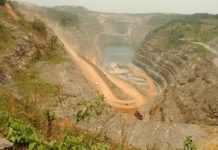
[miningmx.com] — FOR a sobering assessment of the challenges inherent in mining in South Africa, read the section about “risk factors’ in the pre-listing statement released by Royal Bafokeng Platinum (RBPlat) ahead of its JSE listing on 8 November.
The list includes possible nationalisation, possible future problems with black economic empowerment requirements – and this from a company with impeccable empowerment credentials – and a string of warnings about delays and uncertainties in the regulatory process providing essential requirements, such as water licences, surface permits and conversion of prospecting rights.
RBPlat CEO Steve Phiri was justifiably upbeat on its prospects at his presentation to the financial media on October 18 but, in terms of what could still go wrong, the “risk factors’ section makes for depressing reading.
Let’s start with the good news.
Phiri stressed the dispute between major shareholders Royal Bafokeng Holdings
(RBH) and Anglo Platinum (Angloplat) had been settled and all were committed to the
success of RBPlat.
The dispute erupted when Angloplat vetoed the sale of the Bafokeng Rasimone Platinum Mine (BRPM) to rival Impala Platinum (Implats).
RBH wanted that deal to go through – not least because Implats was offering
almost double the R60-odd price RBPlat is looking to place its shares at.
Phiri highlighted the prospect of major organic growth, with RBPlat looking to push
production to one million oz of platinum within 10 to 15 years from the current level of around 270,000oz/year.
Phiri emphasised RBPlat “didn’t have a “for sale’ sign around its neck’ and would
look at merger and acquisition activity only if assets were going really cheap.
“With that kind of prospect, why go and buy someone else’s difficulties unless you can pick it up for a song?’ Phiri asked rhetorically.
RBPlat’s assets are among the best in the platinum business, because the existing
BRPM and the two new shaft systems to be built at Styldrift are all located on the western limb of the Bushveld Complex.
They will mine high-grade Merensky Reef at shallow depths, which gives RBPlat a fundamental competitive advantage over the new mines on the eastern limb of the Bushveld Complex, which have to deal with more complex geology and will be dependent on lower grade UG2 reef.
BUST-UP DISCLAIMER
Phiri stated he had the full commitment of his major shareholders “otherwise I would be out the door like yesterday’.
Maybe so. But it’s worth noting the pre-listing statement specifically warns about
the possible negative impact of any future bust-ups between the two.
The statement notes: “Angloplat has certain minority protections in relation to the
joint venture and there can be no assurance the objectives of the joint venture partners will always be consistent with each other or with the overall objectives
of the company.
“If a dispute arises between the joint venture partners that cannot be resolved amicably they may be involved in lengthy and costly proceedings to resolve the dispute, which could materially and adversely affect the company’s business and results of operations.’
The statement also says “future nationalisation of mines in South Africa could have a significant impact’.
The report notes SA’s Government has publicly ruled out nationalisation in “the short, medium or long term’ but adds: “There can be no assurance the position of the SA Government regarding the issue of nationalisation will not change in the future. Any perception that nationalisation may occur could have a material adverse effect on the trading price of the company’s securities.’
The statement adds the SA Government’s transformation initiatives under the Mining
and Petroleum Resources Development Act (MPRDA) and the Mining Charter “may
have an adverse impact on the company’.
The statement says: “While the regulatory environment is developing, it lacks clarity in a number of areas and is subject to interpretation, review and amendment. A current risk. is compliance with the empowerment requirements as prescribed by the regulatory framework for mining.’
The statement also highlights the problems with water use rights and the delays inherent in obtaining an integrated water use licence because of the “significant backlog in the processing of such applications with the department of water affairs (DWA).
“As a result, certain mines in SA proceed with new water uses without authorisation,’ the statement says.
It adds: “Enforcement by the DWA against all illegal water uses, but particularly
illegal water use within the mining industry, has increased in the past year. Although no specific action has been threatened, it is possible the regulator could refuse to grant a water use licence to an entity which commenced operations without the required licence.’
IN BREACH
That’s not an academic issue included in the prelisting statement as part of
what’s generally known as legal “boiler plate’ or “CYA’ (cover your arse).
Coal of Africa’s Vele coking coal mine in Limpopo province has been shut down
since August because it started mining without an integrated water licence.
The statement adds RBPlat has an integrated water use licence for its Boschkoppie
mine but that licence “is not valid for all of its water uses at its Boschkoppie operations. It is therefore presently technically in breach of the National Water Act (NWA), which could result in enforcement action by the DWA, including a directive to stop all unlawful uses. The company is of the view that the risk of drastic
enforcement action is low.’
The statement also covers safety issues following a directive issued by the department of mineral resources (DMR) against Aquarius Platinum in July, after five mineworkers were killed at its Marikana mine.
The impression at end-July was that that issue had been settled and the DMR had
backed off, but the RBPlat statement appears to indicate that’s not the case.
It states: “The company’s stated reserves could be negatively impacted by a directive issued by the DMR on 19 July 2010, which the company understands is
being enforced on a case-by-case basis. Any reduction of the company’s reserves as a result of this directive could have an adverse effect on its financial condition and results of operations.’
– The article first appeared in Finweek











